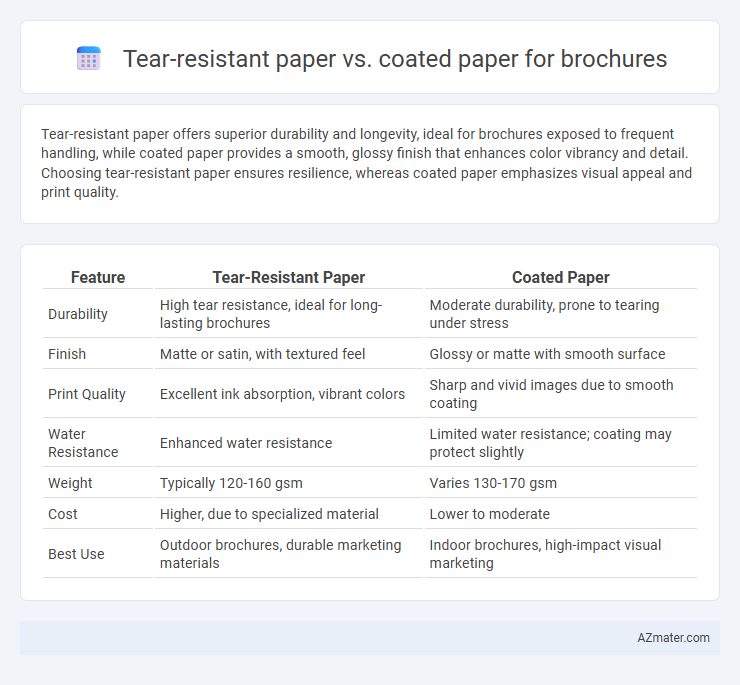Tear-resistant paper offers superior durability and longevity, ideal for brochures exposed to frequent handling, while coated paper provides a smooth, glossy finish that enhances color vibrancy and detail. Choosing tear-resistant paper ensures resilience, whereas coated paper emphasizes visual appeal and print quality.
Table of Comparison
| Feature | Tear-Resistant Paper | Coated Paper |
|---|---|---|
| Durability | High tear resistance, ideal for long-lasting brochures | Moderate durability, prone to tearing under stress |
| Finish | Matte or satin, with textured feel | Glossy or matte with smooth surface |
| Print Quality | Excellent ink absorption, vibrant colors | Sharp and vivid images due to smooth coating |
| Water Resistance | Enhanced water resistance | Limited water resistance; coating may protect slightly |
| Weight | Typically 120-160 gsm | Varies 130-170 gsm |
| Cost | Higher, due to specialized material | Lower to moderate |
| Best Use | Outdoor brochures, durable marketing materials | Indoor brochures, high-impact visual marketing |
Introduction to Brochure Paper Options
Tear-resistant paper offers enhanced durability and longevity, making it ideal for brochures that require frequent handling or outdoor use. Coated paper provides a smooth, glossy finish that enhances color vibrancy and sharpness, perfect for visually rich marketing materials. Choosing between tear-resistant and coated paper depends on the brochure's intended use, audience, and desired tactile experience.
What is Tear-Resistant Paper?
Tear-resistant paper is engineered with reinforced fibers or synthetic blends to enhance durability and prevent rips, making it ideal for brochures exposed to frequent handling or harsh conditions. Coated paper, in contrast, features a smooth, glossy or matte finish that enhances color vibrancy and sharpness but remains more susceptible to tearing under stress. Using tear-resistant paper for brochures ensures long-lasting performance and resilience, particularly in environments requiring robust material.
Overview of Coated Paper
Coated paper features a smooth, glossy, or matte finish achieved by applying a surface coating that enhances color vibrancy and image sharpness, making it ideal for high-quality brochure printing. Its coating helps prevent ink absorption, resulting in crisp, sharp graphics and text with a professional appearance. Compared to tear-resistant paper, coated paper emphasizes visual appeal and print quality over durability and resistance to physical stress.
Durability Comparison: Tear-Resistant vs Coated Paper
Tear-resistant paper offers superior durability for brochures due to its reinforced fibers that prevent ripping and withstand frequent handling, making it ideal for long-term use. Coated paper, while providing a smooth, glossy finish that enhances color vibrancy and print quality, is more prone to tearing and creasing under stress. For brochures requiring extended durability and resilience against wear and tear, tear-resistant paper outperforms coated paper in maintaining structural integrity.
Print Quality and Color Reproduction
Tear-resistant paper offers durability and maintains structural integrity, making it ideal for brochures subjected to frequent handling, while delivering consistent print quality with less risk of smudging or tearing during production. Coated paper provides a smooth, glossy or matte finish that enhances color reproduction by intensifying ink vibrancy and sharpness, resulting in crisp images and vivid colors essential for high-impact brochures. Choosing between tear-resistant and coated paper depends on whether priority lies in brochure longevity with reliable print performance or superior color depth and visual appeal.
Feel and Appearance: Texture and Finish
Tear-resistant paper offers a durable, textured feel that enhances grip and longevity, making brochures suitable for heavy handling and frequent use. Coated paper provides a smooth, glossy or matte finish that intensifies color vibrancy and sharpness, resulting in a sleek and professional appearance. The choice between the two depends on whether a tactile, sturdy experience or a polished, visually striking presentation is prioritized.
Cost Analysis: Tear-Resistant vs Coated Paper
Tear-resistant paper typically incurs higher production costs due to its enhanced durability and specialty fibers, resulting in increased expenses for brochure printing compared to coated paper. Coated paper, with its smooth surface and lower material cost, provides a budget-friendly option while delivering vibrant color reproduction and professional finish. Businesses must weigh the long-term investment in tear-resistant paper's resilience against the upfront savings offered by coated paper for cost-effective brochure distribution.
Suitability for Various Brochure Types
Tear-resistant paper offers exceptional durability, making it ideal for brochures exposed to frequent handling, such as event programs and outdoor promotional materials. Coated paper provides a smooth, glossy finish that enhances color vibrancy, perfect for high-quality image-heavy brochures like product catalogs and luxury brand presentations. Choosing between tear-resistant and coated paper depends on the brochure's intended use, balancing longevity with visual impact to suit marketing goals.
Environmental Impact and Sustainability
Tear-resistant paper for brochures offers enhanced durability and reduces the need for frequent reprints, contributing to lower paper consumption and waste. Coated paper, while providing high-quality print finishes, often involves heavier chemical processing and can be less biodegradable, impacting environmental sustainability negatively. Choosing tear-resistant paper aligns better with eco-friendly practices due to its longer lifespan and reduced environmental footprint.
Choosing the Best Paper for Your Brochure Needs
Tear-resistant paper offers exceptional durability and longevity, making it ideal for brochures subjected to frequent handling or outdoor use where moisture and wear are concerns. Coated paper, available in gloss, matte, or satin finishes, enhances vibrant color reproduction and sharp image quality, perfect for high-impact marketing materials aimed at visual appeal. Selecting between tear-resistant and coated paper depends on your brochure's purpose: prioritize durability for long-term use and coated paper for vivid, polished aesthetics.

Infographic: Tear-resistant paper vs Coated paper for Brochure
 azmater.com
azmater.com